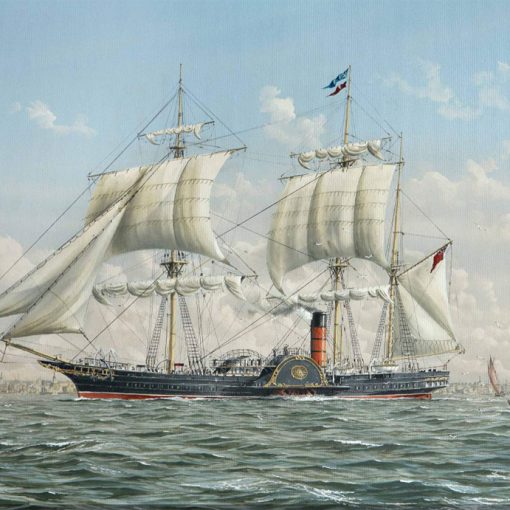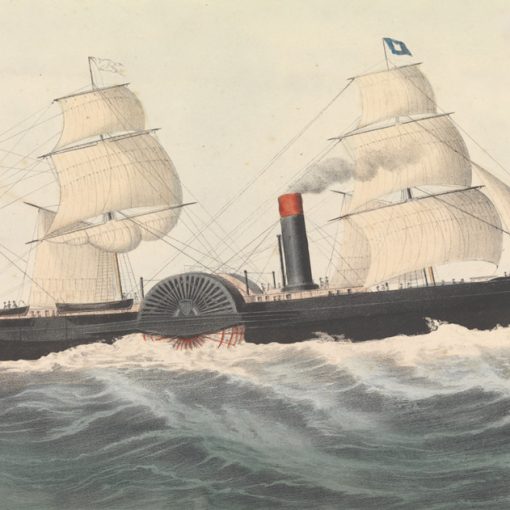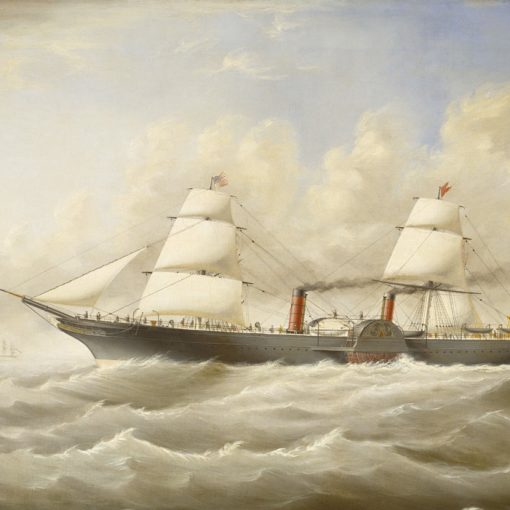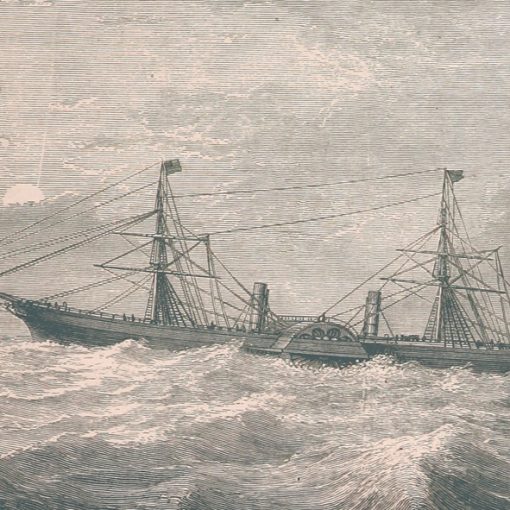1907 – 1934
When it was time for the turn of the century 1800-1900, the supreme ships of the waves were not British ones. At least not the passenger ships, and certainly not the Cunard Line’s vessels. The ship that held the Blue Riband of the Atlantic was Germany’s Deutschland, who had managed to cross the Atlantic with an average speed of about 22 knots. The largest ship in the world was White Star Line’s Oceanic at 17,000 tons and over 700 feet in length. (The ship that finally surpassed the Great Eastern in length, when built in 1899.) This was not acceptable for the Cunard Line, whose greatest liner was the Campania with 13,000 tons and 620 feet in length. At first Cunard (for the glory of Britain, of course) wanted to regain the Blue Riband from the Germans. In 1903 it was decided by Cunard and the government that two ships should be built to re-establish the British ocean superiority. As usual, Cunard was given a large annual amount of money from the government, for the royal mail service across the ocean. This is what gave the ships the right to carry the letters R.M.S. before their name (Royal Mail Ship). A demand these new ships had from the government was that they should be built so that they easily could be refitted as war ships in the event of hostilities.
The two vessels were to be built at two different shipyards. The first at John Brown’s shipping yard, and the second one at Swan, Hunter and Wigham Richardson Ltd. Their service speed was decided to be around 24 or 25 knots, which was enough to pass the Germans.
Another astonishing thing was the size of the new vessels; both ships would be almost 800 feet long and have a tonnage of over 30,000 tons. The new turbine engines that would be built to execute the new speed record of the Atlantic for the latter sister, was trusted to an old acquaintance; Wallsend Slipway and Engineering Co. Ltd., who had produced the engines to the two earlier Cunard vessels Ivernia and Carpathia. The engines would bring their power to four huge, three bladed propellers.
The keel of the now-decided-to-be-named Mauretania was laid in 1904, and in September two years later, she was ready for her launch. In order to carry the launch through properly with such a large vessel, had a 47.5 feet long model of the ship’s hull been launched and tested upon. The actual launch was performed without any problems (except for a workman who was injured by some glass from the wine bottle), and the ship was christened Mauretania by the Dowager Duchess of Roxburgh.
In September 1907, Mauretania went through her sea trials. During these she reached an extremely impressive 27.75 knots. It was clear that the Germans would not stand a chance in competition for the desirable Blue Ribbon.
When Mauretania’s older sister Lusitania entered service she snatched the Blue Riband from the Germans (who would not see a sight of the trophy for over twenty years) on her second voyage. The Mauretania entered the waves only a month later on November 16, 1907, but did not achieve the prize due to bad weather. But she had averaged some 22 knots in spite of the fact that she had anchored for some time because of the storm. But on her way home she took the eastward passage record when averaging 23.69 knots. (The low figures because of fog in the beginning of the voyage.) In the following years a friendly race between Lusitania and Mauretania took place, them frequently taking the prize from one another. But in 1908, the Mauretania damaged one of her propeller blades. When the ship was sent for repairs, Cunard decided that all of Mauretania’s three bladed propellers should be changed to four four bladed ones. This showed in Mauretania’s later performances in a very favourable way. On one of her westward voyages, the Mauretania averaged 26.06 knots, a record that would stand the test of twenty years.
The Mauretania was not only the fastest and largest ship ever built, she was also one of the most luxurious afloat. Even though she could not match the former Riband-holders, she was a spacious and comfortable vessel who became loved and celebrated by her passengers and crew. One of her prime features was the Verandah Café, situated in the aft part of the superstructure. Here, one could have a light meal in the easy breeze from the ocean, framed by three walls but open to the fourth where the fresh sea air would do its curing job brilliantly. Another thing the Mauretania could be proud of was her spacious cabins; especially noteworthy were the second class rooms.
This masterpiece of British engineering was not only claimed to be fast, large and beautiful. Like so many other ships of her day it was believed that she was unsinkable. In one advertisement from the Stone and Lloyd Company, who was those who made watertight doors into the bulkheads inside the ship, it said: ‘The Mauretania is practically unsinkable – owing to the watertight bulkhead doors.’ The ship was like other large vessels inadequately fitted with lifeboats. But after the Titanic disaster had occurred in 1912, the Mauretania was, like the Olympic, fitted with lifeboats for all aboard.
In 1914, the Cunard duo expanded into a trio, when the 45,000-tonner Aquitania entered service. She was not as fast as Lusitania and Mauritania, but considerably larger and more luxurious.
On one of Mauretania’s eastward voyages in August 1914, her captain received information that Britain was now in a state of war with the German Empire. His orders were to bring his ship to Halifax instead of New York. After this, the Mauretania only made a few more voyages, until the Admiralty called her in for war service. Her sister, the Lusitania would remain in passenger service for some time. It was intended that the large passenger vessels would sail as cruisers on the sea carrying heavy artillery and marine soldiers. But only a few months after the beginning of the war, all of Britain’s supplies of coal had been consumed by the large passenger liners. They were considered unsuitable for their decided task, but soon the idea came up that these huge vessels were perfect as troop ships. The Mauretania underwent this refit and in three months in 1915 she shipped over 10,000 soldiers to Greece.
While Mauretania was carrying troops to Greek islands, the Lusitania still carried passengers on the Atlantic immigrant trade route. On one disastrous voyage she was hit by a German torpedo and sunk within twenty minutes, taking with her 1,200 people to the ocean floor. Now the Mauretania was alone.
When the trooping to Greece was completed, the Mauretania was decided to enter a new role as a hospital ship. Her hull was painted white with red crosses along the side. The funnels remained the Cunard company colours: red and black. When completing her task, the Mauretania had transported almost 15,000 wounded soldiers home. In 1917, she was laid up and was not in the immediate danger of the enemies. As we all know, the war ended in 1918, but the Mauretania’s war duties was not over until 1919, when she had shipped the last soldiers to their homes.
Before the war, the ship’s home port had been Liverpool, but as she entered service after the outbreak of peace, it was switched to Southampton, like the White Star Line’s ships. But until the very end of her days, you could read ‘Mauretania – Liverpool’ under her stern.
When peacetime service came for Mauretania, it was obvious that she had suffered from the hard work for the country. On one voyage she only managed to average slightly over 17 knots. Since this meant that for instance the Olympic was much faster than she was, Cunard decided to do something about the Mauretania’s exhausted turbine engines. As this was the time for liner oil conversions, the Mauretania left coal behind and welcomed oil as her new means of drift. In March 1922, she re-entered service and slowly progressed her way from her pedestrian pace to her old speed.
In 1923 the Mauretania was turned into a cruise ship, her hull painted white just as it had been during her hospital ship service in the war. She was chartered by the American Express Company and sailed in the Mediterranean for weeks in a relaxing mood.
The Mauritania’s work continued through the years, with no major mishaps. The passengers loved her, and she was nicknamed ‘The Grand Old Lady’. No ship had yet taken the Blue Riband from her; the old 26.06-knot average was still the best. But that would not last forever. In 1929, a new German liner, the Bremen, with a hundred thousand horsepower, finally took the trophy from the ‘grand old lady’ when averaging 27.87 knots on her maiden westward voyage. On the eastward she managed 27.92. But that was not a large margin, and the Mauretania tried for it again. On her westward voyage she managed 26.9 knots in average, and on the eastward 27.22. She had beaten her own record in both directions, but it was not enough to break the Bremen’s new record.
In the rest of her lifetime, the Mauretania made several ‘Booze Cruises’ from the Americas. (These voyages had this name because of the American passenger’s escape from prohibition at home; only American ships had such laws.) In 1934 Cunard decided to put the Mauretania out of service, and the great ship was sold to a scrap-yard at Rosyth. On her way to be scrapped, Mauretania stopped at the mouth of Tyne, the place where she had been built, and said goodbye to the workers that had once made her 28 years ago. The old ship proudly flew a 20-feet long blue ribbon that said: ‘1907 to 1929’. The crowd of thousands of people greeted the beloved ship with their presence, and the ship fired rockets from the bridge. Everybody joined in the song ‘Auld Lang Syne’, and as the song had finished, tears had been brought into many eyes. Then the Mauretania sailed to meet her fate.
Specifications
- 790 feet (241.3 m) long
- 88 feet (26.9 m) wide
- 31,938 gross tons
- Steam turbines powering four propellers
- 25 knot service speed
- Passenger capacity of 2,335 people
















2 thoughts on “Mauretania (I)”
It is so fascinating to read about old historic ships. And this website only made it better.
Thank you, Rojean. We are really happy that you have enjoyed your time spent here on TGOL!